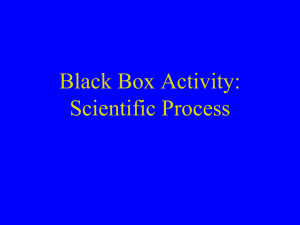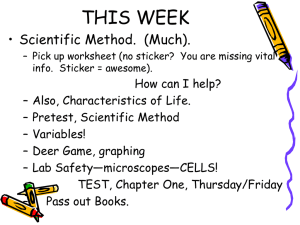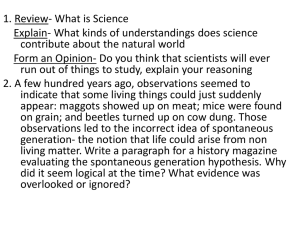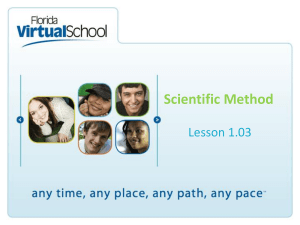The Scientific Method
advertisement
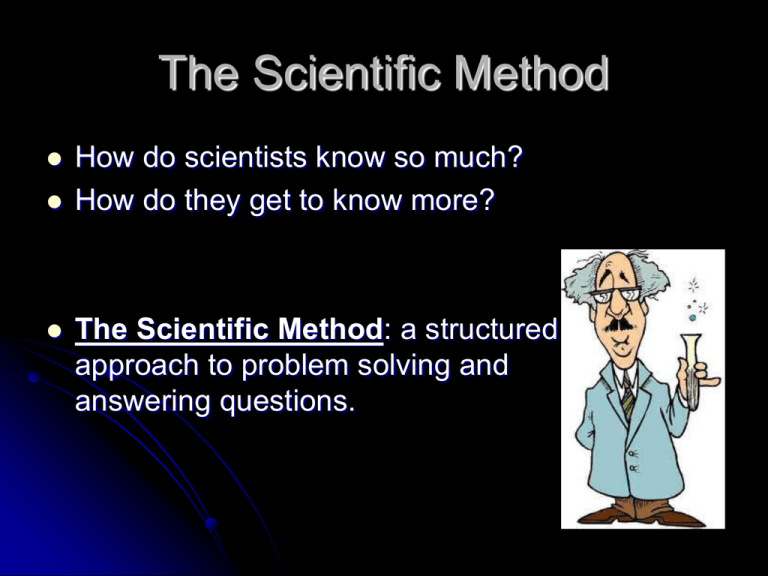
The Scientific Method How do scientists know so much? How do they get to know more? The Scientific Method: a structured approach to problem solving and answering questions. Steps in Scientific Method Make Observations Identify the Problem/Question State the Hypothesis Design a Controlled Experiment Observe and Measure Results (Collect data) Analyze Results and Draw Conclusions Report Results to Scientific Community An Early Scientific Theory Spontaneous Generation: a theory that life can arise from nonlife. Why did people think this was true? Mmmmm Maggots Redi’s Experiment Question: Can life arise from nonlife? Set up experiment using the scientific method. http://www.youtube.com/watch?v=WiGFoYBRYTA&feature=related&safe=active http://www.youtube.com/watch?v=cQIbjhzBkU8&feature=related&safe=active The Scientific Method My car won’t start Method Observe and Ask Questions Infer and Form a Possible Answer (Hypothesis) Design an Experiment to test Hypothesis Collect and Analyze Data Draw a Conclusion Change Hypothesis if necessary and Retest Step #1: Make Observations Helps to define the problem for investigation Step #2 Identify the Problem What is the question you want to ask? Step #3 Form a Hypothesis Hypothesis: Create a scientific explanation (answer to problem) that you can then test Creating a Hypothesis “If _____ then ______” statement Ex: If you add add fertilizer to a plant, then it will grow taller Step #4 Create a Controlled Experiment Two identical groups are set up (control and experimental) Allows you to isolate effects of one variable. Experimental Group: one variable changes Control Group: no variables change, (used as a basis for comparison) Variables Variables: factors that can change (ex: light, time, amount of nutrients, growth) Independent Variable: isn’t influenced by other factors Dependant Variable: “depends” on how the other variable changes Cartoon Variables: http://www.youtube.com/watch?v=x2606G QmDqY&feature=related Step #4 Collect Data Collect data using various research tools (ex: microscope, thermometer, ruler, scale) Follow safety procedures Compile data in a useful form Ex: charts, tables and graphs Types of Data to Collect Quantitative Data: measured “quantitiy” (ex: length, mass, speed, volume, height) Use metric units of measurement Qualitative Data: descriptive “qualities” (ex: gorilla behavior, feather coloration) Step #5 Analyze Data Analyze data to look for patterns or relationships Sample Size and Possible Sources of Error Is it better to do an experiment with just a few samples or many? Why? What possible sources of error might there be ? Graphing Properly Space numbers in equal increments Plot points accurately Connect data points Give title to graph and label axis Graphing Variables Independent variable: on “X” axis Dependant variable: on “Y” axis Step #6 Drawing Conclusions Does your data provide evidence to support the hypothesis? or Should we revise hypothesis and test again? Scientific Method Loop What happens when a hypothesis is not confirmed? Step #7 Report Observations Scientists need to report observations, materials used and procedures to other scientists. Needs to be stated so that someone else could repeat exactly what you did. Scientific Journals Different journals exist for different subfields of science. Scientists read these journals to get new information on recent developments in their fields Before it gets published, a research paper needs to be reviewed by other scientists to make sure that conclusions are supported by data. If your results are verified your hypothesis may get accepted by scientific community Experiment Example Observation: Marsh grass grows taller in some places Question: Why do marsh grasses grow to different heights in different places? Inference: Some environmental factor is limiting grass growth in a salt marsh Hypothesis: Marsh grass growth is limited by amount of nitrogen available in soil Experimental & Control groups start out exactly the same The experimental group changes one variable Independent Variable: nitrogen added Dependant Variable: growth of grass The growth of grass “depends” on nitrogen being added Data collected on height of grass and size of plants Data confirmed that additional nitrogen did allow grass to grow taller and larger than control group Theories and Laws Scientific Theories: explanations that apply to a broad range of phenomena and are supported by strong evidence and data. Ex: Germ Theory of Disease (Louis Pasteur) Diseases are often the effects of microscopic organisms living inside a person. Theory has lead to many effective treatments like antibiotics But not all diseases are caused by germs Scientific Law: Statement that is always true. (Ex: Law of Gravity) Scientific Method Song http://singdancelearn.com/sciencesongs/scientific-method-song/ http://www.youtube.com/watch?v=eA86dYxrg4Q http://www.youtube.com/watch?v=k2MhMsLn9B 0 http://www.youtube.com/watch?v=JcL7det0Ogs Dance http://www.youtube.com/watch?v=RmawlZCEeg g&feature=related The Scientific Method http://aspire.cosmicray.org/labs/scientific_method/sci_method _main.html Plant Experiment http://www.biologycorner.com/worksheets/ scientific_method_plant_exp.html Why does bread turn moldy?



